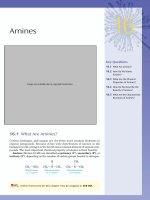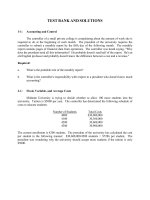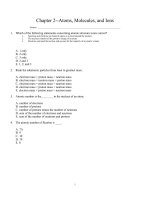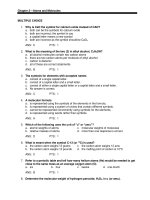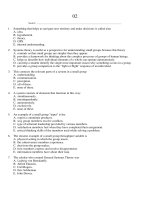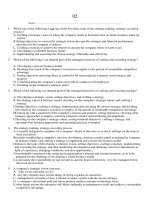Chemistry for today general organic and biochemistry 8th edition seager test bank
Bạn đang xem bản rút gọn của tài liệu. Xem và tải ngay bản đầy đủ của tài liệu tại đây (274.45 KB, 10 trang )
Chapter 2—Atoms and Molecules
MULTIPLE CHOICE
1. Why is CaO the symbol for calcium oxide instead of CAO?
a. both can be the symbols for calcium oxide
b. both are incorrect; the symbol is cao
c. a capital letter means a new symbol
d. both are incorrect as the symbol should be CaOx
ANS: C
PTS: 1
2. What is the meaning of the two (2) in ethyl alcohol, C2H5OH?
a. all alcohol molecules contain two carbon atoms
b. there are two carbon atoms per molecule of ethyl alcohol
c. carbon is diatomic
d. all of these are correct statements
ANS: B
PTS: 1
3. The symbols for elements with accepted names
a. consist of a single capital letter.
b. consist of a capital letter and a small letter.
c. consist of either a single capital letter or a capital letter and a small letter.
d. No answer is correct.
ANS: C
PTS: 1
4. A molecular formula
a. is represented using the symbols of the elements in the formula.
b. is represented using a system of circles that contain different symbols.
c. cannot be represented conveniently using symbols for the elements.
d. is represented using words rather than symbols.
ANS: A
PTS: 1
5. Which of the following uses the unit of "u" or “amu”?
a. atomic weights of atoms
c. molecular weights of molecules
b. relative masses of atoms
d. more than one response is correct
ANS: D
PTS: 1
6. What is meant when the symbol C-12 (or 12C) is used?
a. the carbon atom weighs 12 grams
c. the carbon atom weighs 12 amu
b. the carbon atom weighs 12 pounds
d. the melting point of carbon is 12°C
ANS: C
PTS: 1
7. Refer to a periodic table and tell how many helium atoms (He) would be needed to get
close to the same mass as an average oxygen atom (O).
a. six
b. four
c. twelve
d. one-fourth
ANS: B
PTS: 1
8. Determine the molecular weight of hydrogen peroxide, H2O2, in u (or amu).
a. 17.01
ANS: C
b. 18.02
c. 34.02
d. 33.01
PTS: 1
9. Using whole numbers, determine the molecular weight of calcium hydroxide, Ca(OH)2.
a. 56
b. 57
c. 58
d. 74
ANS: D
PTS: 1
10. The average relative mass of an ozone molecule is 48.0 u. An ozone molecule contains
only oxygen atoms. What does this molecular weight indicate about the formula of the
ozone molecule?
a. It is monoatomic.
c. It is triatomic.
b. It is diatomic.
d. Impossible to determine
ANS: C
PTS: 1
11. Which of the following pairs are about equal in mass?
a. proton and electron
c. proton and neutron
b. electron and neutron
d. nucleus and surrounding electrons
ANS: C
PTS: 1
12. Which of the following particles is the smallest?
a. proton
c. neutron
b. electron
d. they are all the same size
ANS: B
PTS: 1
13. How many electrons are in a neutral atom of carbon-13 (13C)?
a. 6
b. 18
c. 12
d. no way to tell
ANS: A
PTS: 1
14. Which of the following carries a negative charge?
a. a proton
c. an electron
b. a neutron
d. both proton and neutron
ANS: C
PTS: 1
15. Which of the following is located in the nucleus of an atom?
a. protons
c. electrons
b. neutrons
d. protons and neutrons
ANS: D
PTS: 1
16. Atoms are neutral. How can they have no charge?
a. equal numbers of protons and neutrons
b. equal numbers of protons and electrons
c. equal numbers of neutrons and electrons
d. any charge has been drained out of the atom
ANS: B
PTS: 1
17. Isotopes differ from each other in what way?
a. They have different numbers of protons in the nucleus.
b. They have different numbers of neutrons in the nucleus.
c. They have different numbers of electrons outside the nucleus.
d. More than one response is correct.
ANS: B
PTS: 1
18. What is the reason that U-238 is different from U-235?
a. three more electrons
c. three more neutrons
b. three more protons
d. there is no difference
ANS: C
PTS: 1
19. How many protons are found in the nucleus of a boron-11 (11B) atom?
a. 11
b. 6
c. 5
d. 4
ANS: C
PTS: 1
20. How many neutrons are found in the nucleus of a boron-11 (11B) atom?
a. 11
b. 6
c. 5
d. 4
ANS: B
PTS: 1
21. What is the mass number of a carbon-13 (13C) atom?
a. 13
b. 12
c. 6
ANS: A
d. 7
PTS: 1
22. Naturally occurring neon (Ne) has the following isotopic composition (the mass of
each isotope is given in parenthesis). Calculate the atomic weight of neon in u from
these data: neon-20, 90.92% (19.99 u); neon-21, 0.257% (20.99 u); neon-22, 8.82%
(21.99 u)
a. 28.97
b. 37.62
c. 2017
d. 20.17
ANS: D
PTS: 1
23. Naturally occurring lithium (Li) consists of only two isotopes, Li-6 (6.02 u) and Li-7
(7.02 u), where the isotopic masses are given in parentheses. Use the periodic table
and determine which isotope is present in the larger percentage in the natural element.
a. Li-6
b. Li-7
c. each is present at 50%
d. cannot be determined from the information available
ANS: B
PTS: 1
24. What mass of arsenic (As) in grams contains the same number of atoms as 39.95 g of
argon (Ar)?
a. 33.0
b. 74.92
c. 4.16
d. 149.84
ANS: B
PTS: 1
25. The number of Cr atoms in a 26.0 g sample of chromium is x. How many atoms,
expressed in terms of x, would be contained in 26.98 g of aluminum (Al)?
a. x
b. x/2
c. 2x
d. x+2
ANS: C
PTS: 1
26. The mass of mercury (Hg), a liquid at room temperature, is 200.6 amu/mol. A 200.6
gram sample of mercury is heated until it boils. What is the mass of one mole of
mercury vapor (gas)?
a. <200.6 or it wouldn’t be a gas
c. the same as when it is a liquid
b. the same as Avogadro's number
d. none of the answers are correct
ANS: C
PTS: 1
27. The formula for dinitrogen monoxide is N2O. If a sample of the oxide was found to
contain 0.0800 g of oxygen, how many grams of nitrogen would it contain?
a. 0.140
b. 0.280
c. 0.560
d. 0.0700
ANS: A
PTS: 1
28. One Avogadro's number of iron (Fe) atoms would weigh _____ .
a. 55.9 g.
c. 55.9 u.
b. 6.02 1023 g.
d. 6.02 1023 g.
ANS: A
PTS: 1
29. How many atoms are contained in a sample of krypton, Kr, that weighs 8.38 g?
a. one Avogadro's number
c. one
b. one-tenth Avogadro's number
d. one-tenth
ANS: B
PTS: 1
30. Which of the following has the largest mass?
a. 5.0 mol H2O
b. 3.5 mol NH3
c. 8.0 mol C
ANS: D
d. 6.0 mol C2H2
PTS: 1
31. How many silicon atoms (Si) are contained in a 12.5 g sample of silicon?
a. 2.68 1023
b. 5.83 1022
c. 1.35 1024
d. 1.71 1021
ANS: A
PTS: 1
32. What is the number of hydrogen atoms in a 18.016 gram sample of water?
a. 2.000
b. 6.022 1023
c. 18.02
d. 1.204 1024
ANS: D
PTS: 1
33. How many moles of oxygen atoms are in one mole of CO2?
a. 1
b. 2
c. 6.02 1023
d. 12.04 1023
ANS: B
PTS: 1
34. How many hydrogen atoms are in 1.00 mole of NH3?
a. 3.00
b. 6.02 1023
c. 12.0 1023
ANS: D
d. 18.1 1023
PTS: 1
35. How many moles of hydrogen molecules (H2) would be required to produce two moles
of hydrogen peroxide (H2O2)?
a. 1
b. 2
c. 3
d. 4
ANS: B
PTS: 1
36. Calculate the weight percentage of hydrogen in water.
a. 33.3
b. 66.7
c. 2.00
ANS: D
d. 11.1
PTS: 1
37. What is the weight percentage of nitrogen in urea, CN2H4O?
a. 46.7
b. 30.4
c. 32.6
d. 16.3
ANS: A
PTS: 1
38. How many carbon atoms are contained in 5.50 g of ethane, C2H6?
a. 2.75 1022
b. 3.29 1024
c. 1.10 1023
d. 2.21 1023
ANS: D
PTS: 1
39. Which element is approximately 65 percent of sulfuric acid by weight?
a. hydrogen
b. sulfur
c. oxygen
d. any of these
ANS: C
PTS: 1
40. How many moles of N2O contain the same number of nitrogen atoms as 4.60 g of NO2?
a. 0.500
b. 0.0500
c. 0.100
d. 0.200
ANS: B
PTS: 1
41. How many grams of iron (Fe) is contained in 15.8 g of Fe(OH)3?
a. 12.1
b. 8.26
c. 11.8
d. 5.21
ANS: B
PTS: 1
42. The symbol for bromine is _____ .
a. B
b. Br
ANS: B
d. none of these
c. 54.4%
d. 22.4%
PTS: 1
43. The weight % of S in K2SO4 is _____ .
a. 14.2%
b. 18.4%
ANS: B
c. Be
PTS: 1
44. What is the number of moles of water in one liter of water if one gram of water takes
up one milliliter of space?
a. 1
b. 18
c. 55.6
d. 1000
ANS: C
PTS: 1
45. How many neutrons are in an atom that has a mass number of 75 and contains 35
protons?
a. 40
b. 35
c. 75
d. can’t tell
ANS: A
PTS: 1
46. Atoms that have the same atomic number but differ by mass number are called?
a. protons
b. neutrons
c. isotopes
d. positrons
ANS: C
PTS: 1
47. If you have 3.011 1023 atoms of carbon, what would you expect its mass to be?
a. 12.01 g
b. 6.005 g
c. 3.003 g
d. 1.000 g
ANS: B
PTS: 1
48. What is wrong with the following molecular formula: SOO (sulfur dioxide)?
a. OSO is the correct form
c. OO should be written as O2
b. SO should be So
d. OO should be written as O2
ANS: D
PTS: 1
49. Determine the number of electrons and protons in the element Tc.
a. 43 protons, 43 electrons
c. 56 protons, 43 electrons
b. 43 protons, 56 electrons
d. 99 protons, 43 electrons
ANS: A
PTS: 1
50. The system of atomic mass units is based on
a. assigning 12C as weighing exactly 12 u & comparing other elements to it.
b. measuring the true mass of each subatomic particle.
c. comparing the differences in protons and electrons.
d. viewing how atoms are affected by electromagnetic fields.
ANS: A
PTS: 1
51. How many moles of Na2Cr2O7 contain 14 moles of oxygen atoms?
a. 2 mol Na2Cr2O7
c. 7 mol Na2Cr2O7
b. 14 mol Na2Cr2O7
d. 1 mol Na2Cr2O7
ANS: A
PTS: 1
52. An isotope of a given element has a mass number equal to twice the atomic number.
This neutral isotope contains twelve electrons. This isotope is _____ .
a. magnesium-12.
c. chromium-24.
b. magnesium-24.
d. chromium-12.
ANS: B
PTS: 1
53. Approximately, how many atoms of beryllium would be required to equal the mass of
10 atoms of aluminum?
a. 3 atoms of beryllium
c. 30 atoms of beryllium
b. 10 atoms of beryllium
d. 4 atoms of beryllium
ANS: C
PTS: 1
54. If calcium carbonate found in limestone is 40.0% calcium, how many grams of calcium
are in 485 g of calcium carbonate?
a. 12.1 g of calcium
c. 19,400 g of calcium
b. 291 g of calcium
d. 194 g of calcium
ANS: D
PTS: 1
55. Which of the following correctly describes subatomic particles?
1. Mass:
<
=n
2. Magnitude of charge:
n<
=
a. 1 only
ANS: D
3. Location: outside nucleus
,
b. 2 only
c. 3 only
, inside nucleus
d. 1 and 2
n
PTS: 1
56. Write the formula for a compound consisting of 3 sodium atoms, 1 phosphorus atom,
and 4 oxygen atoms.
a. S3PO4
b. 3NaP4O
c. Na3P2(O2)
d. Na3PO4
ANS: D
PTS: 1
57. Consider the representation shown below. It should be classified as
a.
b.
c.
d.
an element consisting of 6 atoms.
a compound containing atoms of two elements.
a homogenous mixture of two elements.
a homogenous mixture of two compounds.
ANS: B
PTS: 1
58. A neutral isotope of an element contains 21 electrons and 24 neutrons. What is the
following representation for this nucleus?
a.
b.
c.
d.
ANS: B
PTS: 1
59. How many electrons are found around the species below?
a. -2
ANS: B
b. 0
61.
d. 4
c. 369.63 g/mol
d. 601.92 g/mol
PTS: 1
60. What is the molar mass of Ba3(PO4)2?
a. 232.30 g/mol
b. 327.27 g/mol
ANS: D
c. 2
PTS: 1
is the form of uranium used to make atomic bombs. One atom of this isotope
consists of ___.
a. 92 protons, 92 electrons, 92 neutrons
b. 92 protons, 143 electrons, 92 neutrons
c. 92 protons, 92 electrons. 143 neutrons
d. 143 protons, 143 electrons, 92 neutrons
ANS: C
PTS: 1
62. Oxalic acid is found in many plants, like spinach and black tea. What is the mass of
the carbon found in one mole of oxalic acid, H2C2O4?
a. 12.01 g of C
b. 24.02 g of Cl
c. 45.01 g of C
d. 90.02 g of C
ANS: B
PTS: 1
63. You discover a new element which consists of two isotopes. The first isotope, 243X
(mass = 242.45 u) comprises 40.000% of the total. The second isotope, 248X (mass =
247.11 u) accounts for the rest. What would be the average atomic mass for your new
element?
a. 242.45 u
b. 244.32 u
c. 245.25
d. 247.11
ANS: C
PTS: 1
64. Individuals, ages 19-70, should include at least 1000 mg of calcium in their daily diet.
What is the minimum number of one-gram calcium supplement tablets you would need
to take each day to meet this requirement if a tablet is 40% by mass calcium?
a. 1
b. 2
c. 3
d. 4
ANS: C
PTS: 1
TRUE/FALSE
1. The symbols for all of the elements are derived from the Latin names.
ANS: F
PTS: 1
2. The symbols for all of the elements always begin with a capital letter.
ANS: T
PTS: 1
3. The first letter of the symbol for each of the elements is the first letter of its English
name.
ANS: F
PTS: 1
4. The most accurate way to determine atomic mass is with a mass spectrometer.
ANS: T
PTS: 1
5. H2O2 contains equal parts by weight of hydrogen and oxygen.
ANS: F
PTS: 1
6. Electrons do not make an important contribution to the mass of an atom.
ANS: T
PTS: 1
7. The charge of the nucleus depends only on the atomic number.
ANS: T
PTS: 1
8. Isotopes of the same element always have the same number of neutrons.
ANS: F
PTS: 1
9. Isotopes of the same element always have the same atomic number.
ANS: T
PTS: 1
10. Isotopes of the same element always have the same atomic mass.
ANS: F
PTS: 1
11. A mole of copper contains the same number of atoms as a mole of zinc.
ANS: T
PTS: 1
12. One mole of an element would weigh the same as a mole of an isotope of the same
element.
ANS: F
PTS: 1
13. One mole of silver would contain the same number of atoms as a mole of gold.
ANS: T
PTS: 1
14. One mole of an element would weigh the same as a mole of an isotope of the same
element.
ANS: T
PTS: 1
15. One mole of H2O contains 2.0 grams of hydrogen.
ANS: T
PTS: 1
16. One mole of O3 weighs 16 grams.
ANS: F
PTS: 1
17. The pure substance, water, contains both hydrogen molecules and oxygen molecules.
ANS: F
PTS: 1
18. A diet is planned for a trip on a space ship and is lacking in milk, but is rich in turnips
and broccoli. Such a diet could provide a sufficient amount of calcium for adults.
ANS: T
PTS: 1
19. Calcium supplements can be taken in 1,000 mg increments.
ANS: F
PTS: 1
20. Protons and neutrons have approximately the same mass.
ANS: T
PTS: 1
21. Neutral isotopes of the same element have the same number of electrons.
ANS: T
PTS: 1
22. An isotope of gallium consisting of 31 protons and 37 neutrons can be represented
using the symbol shown below.
ANS: F
PTS: 1
23. The atomic mass number is a whole number and indicates a specific isotope of an
element.
ANS: T
PTS: 1
24. In naturally occurring samples, all elements exist as a mixture of isotopes.
ANS: F
PTS: 1
25. One mole of any substance will contain one Avogadro’s number of atoms of that
substance.
ANS: F
PTS: 1
26. A scanning tunneling microscope (STM) relies on a very strong light source to help
see atoms.
ANS: F
PTS: 1
27. An MRI instrument cause the hydrogens in your body to line up because they are
exposed to a very strong magnetic field.
ANS: T
PTS: 1

